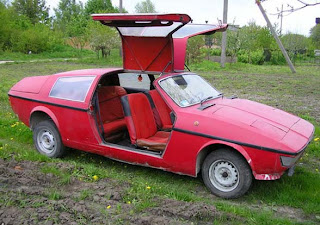Fiberglass was developed, as most things are, out of necessity during WWII in the UK as a replacement for the molded plywood used in aircraft radomes. But its lightweight-yet-incredibly-strong characteristics would not go unnoticed. As soon as the application became commercially acceptable for boatbuilding, fiberglass' use exploded.
Up until around the 60s surfboard craftsmen were making boards out of balsa wood, with its foam-like characteristics and fast growth in tropical climates, it was almost as if it was meant to be. Then came fiberglass. After realizing they could make "blank" surfboards out of polyurethane foam and give them a coat or two of fiberglass cloth and resin, boardmakers changed the face of surfing forever.
Being lighter and more rigid than balsa, the new wrapped foam technique allowed for tighter turns and "snappier" tricks. Being stronger, it let surfers place larger bets on bigger, faster waves. And when the 70s came about, many board makers realized that they could get away with six or so feet of board, instead of the previous nine. That was the birth of the shortboard. That was when surfing really changed.
The tricks got more complex, the riders, more daring. And as production on the chemicals necessary to make a board became cheaper and more available, the sport exploded. But, further inland, fiberglass was finding another way to alter the Coastal California landscape.
Right around the same time fiberglass was hitting puberty, automobile production was like its younger brother, just a few steps behind. In the 50s, 60s and 70s, car makers were struggling with a way to keep the steel bodies of their autos from rusting and falling apart. Paint was not yet strong enough to survive total exposure to the elements for more than a few years, and rustproofing as we know it today was in its infancy.
Wrecker yards were full of perfectly good cars... with terrible bodies. Then, almost collectively, a bunch of DIY guys working in the shadows of home garages came up with a solution; if one couldn't afford a sports car, one could afford an old chassis and motor and a fiberglass body kit. Not technically the birth of the kit car, but definitely the first shots fired in the Kit Kar revolution.
Southern California. Late 60s, early 70s. This is where things get interesting. VW is on a roll, the Beetle is unstoppable. It's small, lightweight, has rear wheel drive. Phenomenal on gas. Won't overheat. Simple enough to rebuild in a home garage with a modest tool kit. All that, and there are literally thousands of them, like pigeons in New York. It's a dune racer's dream. Except that it's ugly. And a little bit useless for tooling around on the beaches.
So Bruce Meyers fixes the problem almost overnight by inventing the Meyers Manx. It's the first SoCal cruiser the world had ever seen. And it performed like a champ. Ads for his Manxter hit every car and sport magazine around and between 1964 and 1971 he made 6000 of 'em. And copies worldwide surpassed 125,000 just as fast. Meyers had created a frenzy. He made the quintessential SoCal vehicle for the time period. A body style so classically Californian that it's still in production today. And all the home technician had to do was pull the body off a Beetle, shorten the frame, and bolt the kit on.
Meyers also opened the floodgates for many other Kit Kars to be produced, all of which seem to elevate in complexity, including his own Manxter II. Porsche's were an easy rip off; Porsche designed the Beetle like an economy version of his speedsters. All someone had to do was swap the steel body for a sleek fiberglass one and they were James Dean for $50k less than the original.
But designers didn't stop there. The VW platform was most commonly used because it was so simple and abundant. But pretty much any frame-on-chassis car or truck could be used, and the possibilities were endless. Corvettes, Lamborghinis, Ferraris are all able to be duplicated using a wide variety of "donor vehicles". Some were incredible; some, downright goofy.
The popularity of the Kit Kar died off with the DIY attitude of the American People. As her citizens became less and less likely to stay up late in garages converting old cars into functioning works of art, automakers started to push their idea of "customized" cars. Dealer- or factory-installed options replaced wrenches and America lost a little bit more of it's soul; but we call that the 80s and 90s and it's another story altogether.



















No comments:
Post a Comment